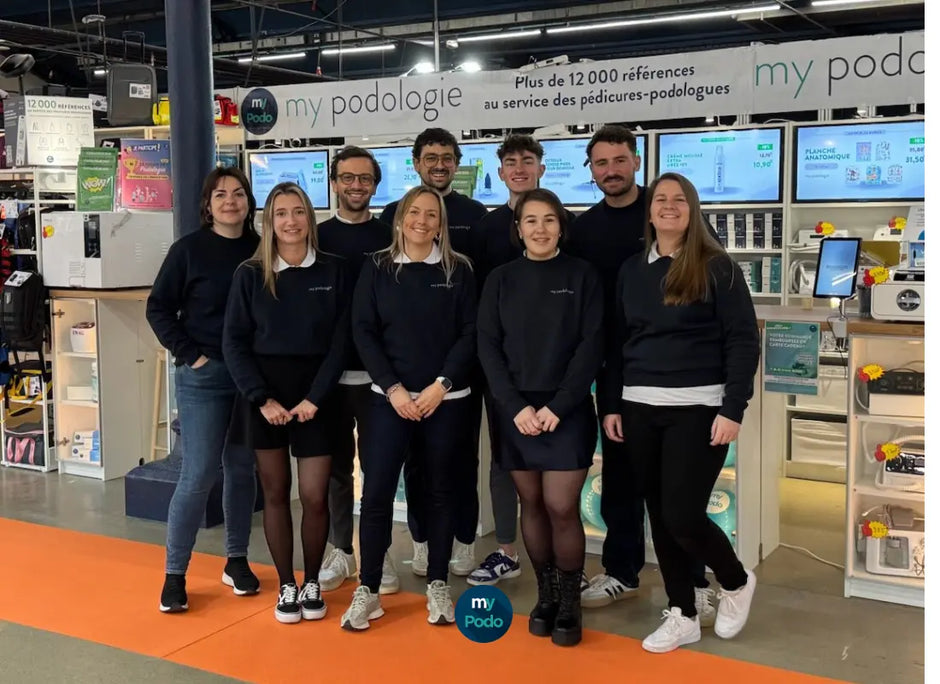What is a wart?
They hurt us, they are an ordeal for our feet: warts. The sworn enemies of our children's feet are here!
A wart is simply a condition caused by a virus that penetrates the skin. It is a small, well-defined, more or less massive outgrowth of the cornea. In its center and under the cornea, there are several blood papillae. It is part of the papillomavirus family and has the particularity of being very contagious. In Chiropody-Podiatry, we can most often find them on the plantar surface of the foot. Due to its painless nature, the patient does not systematically discover its presence. He generally discovers it when the wart has become more mature. In this case, a sharp pain is described under the foot. However, unlike a corn, the wart is characterized by pain when pressed on the side.
How are they formed?
The virus, to contaminate the individual, must pass through an entry point which can be either a micro-wound, a superficial abrasion of the skin or other conditions of the same kind. Then, if the virus is not taken care of and neutralized by the individual's immunity, the affected area will produce cellular hyperplasia at the origin of the formation of the horny mass. The appearance of a wart after contamination occurs in a very variable manner depending on the person. The incubation period of the virus is generally between 8 and 24 weeks, that is to say from the moment the person was exposed to the virus, until the appearance of the wart.
How to do they transmit?
As mentioned above, a wart is very contagious. It infects people through several modes of transmission. We can catch a wart if we come into direct contact with an infected person, but also if we come into contact with a material, an object, a surface where the virus is present.
There are places or activities that promote contamination. For example, we all know that municipal swimming pools, public showers, wet surfaces, stagnant bodies of water, judo mats, walking barefoot, etc. are all breeding grounds for contamination. We should also not overlook the fact that a person with a wart can contaminate themselves. Indeed, if the person picks at their wart and lets blood flow, the virus can spread and reach another part of the body through self-contact.
Possible complications
Like most existing pathologies, warts can also become complicated. The appearance of constant pain even at rest, anarchic multiplication, a painful appearance, redness around the warts or other signs of infection, can lead us to think that there is a complication. Treating physicians or dermatologists are therefore the people to consult in the event of complications.
Due to its non-aesthetic, sometimes painful and disabling nature, the patient can consult a Chiropodist-Podiatrist to treat a wart. For this, the competent health professional can use Vercid, a product proposed by Dr. Jouille. To treat a wart with this product, the Chiropodist-Podiatrist must follow a certain protocol.
The treatment protocol for a wart with Vercid by a chiropodist-podiatrist according to Doctor Jouille
Formerly called Verrucide , Vercid is a product invented by Doctor Jouille which aims to treat all skin growths, hyperkeratosis on the feet. It is a product whose mission is not to detach and eliminate the keratin layer of the skin like all keratolytics, but rather to penetrate the skin more easily. Due to its destructive action, the biological bonds between the skin cells will detach, thus facilitating the removal of the wart. Dr. Jouille's Vercid does not burn the tissues. It generally only takes 2 or 3 applications, including one application per treatment, for the product to take effect. Dr. Jouille's Vercid gives the treated area a good healing capacity. Please note, this product is for strictly professional use!
The use of Vercid must be done with great caution for patients with fragile skin such as diabetics, arteriopathics, neuropathics. In these types of patients at risk, improper use of the product can be dangerous.
In order to carry out the protocol, you will need Dr. Jouille's Vercid, a 2.5m Blenderm, a cement spatula, gloves, a pair of scissors, a scalpel handle and a Swann Morton scalpel blade, a gouge blade holder and a gouge blade.
The treatment of a wart according to the Jouille protocol extends into 3 main phases which are:
DAY 1: Start treatment with the first application
- eliminate superficial hyperkeratosis
- apply Vercid to the area using a cement spatula and then wait a few minutes
- scrub the treated area again
- carry out a second application, followed by covering the area with an occlusive adhesive tape (Blenderm 2.5m)
- finish the design of the dressing, by adding a compress topped with a tape
DAY 2: Mid-treatment with the second application
- 1 to 2 days after the first application, scrub the area again as deeply as possible in order to remove as much of the treated tissue as possible.
- apply Vercid again
- design the same dressing as Day #1
DAY 3: End of treatment with the last application

When the treatment is finished, it is possible to see a small blister appear on the treated area. This is completely normal, as it demonstrates the successful treatment by the product.
Please note that Dr. Jouille's Vercid is a product that remains quite powerful. Pain may occur during the treatment phases. If the pain related to the action of the product persists, taking an analgesic is recommended to calm the pain. If it still does not calm down, wash with soapy water in order to stop the action of the product. Dr. Jouille's Vercid must be used by a healthcare professional, whether a chiropodist, doctor or dermatologist. If you have not received medical training, please do not purchase or use this product for personal purposes.







